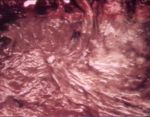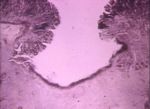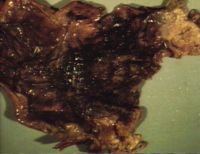Category:Stomach and Abomasum - Inflammatory Pathology
| This article has been peer reviewed but is awaiting expert review. If you would like to help with this, please see more information about expert reviewing. |
|
|
- Gastritis refers to inflammation of the stomach.
Catarrhal gastritis
Clinical
- Catarrhal gastritis can be fatal since it makes the animal vomit and can produce rapid dehydration.
- May die in day or two if vomiting is persistent and untreated.
- Extracellular fluid (isontonic) is lost, and so blood very quickly becomes viscous.
- Death may occur from hypovolaemic shock
- Particularly in young animals (can be very quick).
- Death may occur from hypovolaemic shock
Pathology
- The mucosa appears swollen and hyperaemic, with thickened rugae.
- Mild inflammation, hyperaemia, and oedema
- Infiltration of inflammatory cells
- No fibrin or haemorrhage.
- The surface of the mucosa is covered by a white, sticky catarrhal exudate which lines the stomach.
Pathogenesis
- There are numerous causes of catarrhal gastritis
- Ingestion of mild irritant
- Systemic bacterial diseases
- Infectious enteric diseases e.g.
- Transmissible gastro enteritis (TGE)
- E.coli
- Salmonella etc.
- Dogs are very prone catarrhal gastritis.
Oedema Disease In The Pig
- Catarrhal gastritis is an important characterisitic of this condition
- Oedema disease is a sporadic condition that can become important on some farms.
Clinical
- Generally occurs in young pigs, though sometimes in older pigs
- 7-10 days after major change in diet e.g. weaning.
- Signs include
- No diarrhoea
- Puffy eyelids
- High-pitched voice (oedema of larynx)
- Sitting on haunched
- "Star-gazing" due to cerebral oedema (hallucinations?).
- Animals usually die.
- Disease develops very quickly so pigs do not have time to go off food.
Pathogenesis
- Oedema disease is an enterotoxaemia associated with infection by enterotoxigenic E.coli.
- Verotoxin/ shiga toxin- producing E. coli proliferate in the small intestine
- Especially O138, O139, and O141.
- Organisms remain in the gut (are not invasive).
- Labile shiga-like toxin II is absorbed into body, producing effects everywhere.
- Blood vessel walls are damaged and become very leaky, producing oedema everywhere.
- Histological blood vessel changes are subtle.
- Fibrinoid degeneration of media in small arteries.
Pathology
- An important characteristic of oedema disease is the occurrence of catarrhal gastritis and marked oedema in the stomach mucosa and wall.
- Also oedema of various organs, particularly between coils of spiral colon.
Diagnosis
- Clinical signs are characteristic.
- Also by culture and typing of E. coli from gut
Erosive and Ulcerative Gastritis
- Causes gastric ulcers
- Seen
- Commonly in the dog and pig.
- In young calves weaned onto a coarse diet.
- These usually heal as animal gets older.
- In the horse, associated with parasites.
- Once started, gastric ulcers can erode deeply.
- May penetrate gastric wall leading to peritonitis.
- May erode a blood vessel to cause haemorrhage.
Pathology
Gross
- Round or oval lesions from 1-4 cm in diameter.
- Sharply “punched out” lesions with perpendicular or slightly overhanging walls.
- Borders are level with, or slightly raised above, the surrounding mucosa.
- Depth is variable.
- Some penetrate the superficial mucosa only.
- Some deeply penetrate the muscularis externa.
- Base may be markedly haemorrhagic.
- In advanced chronic cases, scarring may result in a puckered appearance.
Histological
- Appearance varies with the degree aggressiveness of the ulcer and the amount of healing which has occurred.
- Rapidly excavating ulcers have minimal granulation tissue and collagen deposition.
- Others may have a necrotic base with a framework of granulation tissue and collagen.
- The blood vessels at the base of the ulcer may be thickened and thrombosed.
- In the bovine, the ulcer may have a superimposed fungal infection.
Pathogenesis
- There are differences in pathogenesis between species.
Cattle
- Management-related in young calves and dairy cows.
- May also be caused by infectious agents, e.g. mucosal disease/ bovine viral diarrhoea virus.
- Ulcers have a tendency to bleed and perforate.
Horse
- Affects the pars oesophagea (margo plicatus) in adults and foals.
- Due to parasites - Gasterophilus (Bots).
- Bots are not as common as they once were.
- Look like big pink maggots.
- Killed by Ivermectin.
- Gasterophilus leave large ulcers in glandular regions of the stomach.
- Ulcers / erosions are quite deep.
- The parasites are believed to be non-pathogenic, but in large numbers they probably produce some discomfort and poor growth.
- Carcinoma can also produce ulceration in the stomach of the horse as, in other species.
- In foals, the glandular area may sometimes be affected.
- This may be e.g. stress-related, or due to used of NSAIDs.
Dog
- Although ulcers are often secondary to other diseases, primary idiopathic peptic ulcers do occur, due to
- Hyperacidity
- Gastric carcinoma in older dog
- Secondary ulcers are often associated with systemic diseases particularly uraemia and mast cell tumours. Gastric ulcer may be the cause of death but is not the primary disease.
- Mast cell tumours
- Boxers and Labradors are predisposed to these.
- Vomit continually together with abdominal pain.
- Ulcers are usually near the duodenum.
- Frequently secondarily infected.
- Often penetrate deeply.
- Actively secreting mast cell tumours produce histame, leasing to gastric hyperacidity and therefore secondary peptic ulcers.
- Uraemia
- Gastric lesions usually occur with chronic renal disease.
- Gastrin is produced by the G cells of the gastric antrum during the gastric phase of digestion .
- Acts on H2 receptors on parietal cells to increase production of HCl.
- Increases release of histamine from gastric mucosal mast cells to increase HCl release.
- Serum levels of gastrin are increased in chronic renal disease in dogs and cats.
- Gastrin is produced by the G cells of the gastric antrum during the gastric phase of digestion .
- In acute renal failure death ensues before gastric ulceration develops.
- Pathogenesis
- Loss of nephron and medullary concentration gradient in chronic interstitial nephritis mean collecting ducts cannot resorb fluid.
- A common cause of interstitial nephritis in the dog was leptospirosis.
- Consequently, the animal drinks and urinates in enormous quantities, and urea is washed out with large quantities of fluid ("compensated renal failure").
- If fluid is restricted, urea cannot be washed out and the animal becomes uraemic.
- Urea in the stomach breaks down to ammonia, irritating the mucosa and contributing to gastric ulcer.
- Uraemia also causes arteriolar degeneration in the submucosa, leading to hypoxic damage to the mucosa. This is another contributing factor to gastric ulcer.
- Vomiting causes dehydration and further raises blood urea.
- A vicious circle is produced- ends in death by vomiting, dehydration and shock.
- Note: If an animal in compensated renal failure is given anaesthetic, it will not drink much. It then may start to vomit and die due to uraemia.
- Loss of nephron and medullary concentration gradient in chronic interstitial nephritis mean collecting ducts cannot resorb fluid.
- Gastric lesions usually occur with chronic renal disease.
- Mast cell tumours
- NSAIDs, Zollinger-Ellison syndrome (due to pancreatic gastrin-secreting tumour), cirrhosis and bile reflux can all also cause gastric ulcers in the dog.
Pig
- Gastic ulceration is quite common in the pig- May be seen in 50-60% of pigs arriving at slaughterhouses.
- Has serious economic consequences.
- Clinical
- Occasionally a well-grown pig will drop dead.
- Deep ulcers have eroded into a blood vessel, causing massive haemorrhage into the stomach from and producing death very rapidly.
- If long standing ulcers do not result in death, they do produce pain and discomfort.
- Give low growth rate and poor feed conversion.
- Occasionally a well-grown pig will drop dead.
- Pathogenesis
- Gastric ulceration is associated with modern pig rearing, but the exact cause is unknown.
- Causes are associated with gastric hyperacidity, and gastric ulceration is probably a multifactorial disease.
- The following are suggested as possible causes:
- Infection, e.g. Candida albicans, Streptococci, Staphylococci and mixes of these.
- Copper toxicity- this is probably more significant.
- Pigs are fed copper as growth promoter; 50 ppm is know to be toxic, and animals are often fed 250 ppm.
- Vitamin E / Selenium deficiency.
- Feeding on concrete floors.
- Sand is licked up whe pigs eat.
- Feeding finely milled cereal.
- Stress
- Possibly genetic factors.
- Pathology
- Most commonly affects pars oesophagea (squamous or non-glandular portion).
- Starts with hyperkeratosis in the stratum corneum
- Appears rough and thickened
- May stop at this stage.
- In approximately 30% of animals, the lesion starts to erode and quite deep ulcers may develop.
- In a significant small number ,very deep ulcers develop and may affect virtually all of pars oesophagea.
- Histologically, ulcers are large and flask-shaped ulcer with fibrin, necrosis, erosion and fibrosis at base.
Fibrinous/ Diptheric Gastritis
- Not very common, but has severe consequences.
- Dirty-white, crumbly fibrin is seen on the surface of mucosa.
- Causes
- Toxic
- From drinking battery acid or other caustic material.
- Also gives with stomatitis and oesophagitis as well.
- Poisons such as mercuric chloride and carbolic acid also cause fibrinous/ diptheric gastritis.
- From drinking battery acid or other caustic material.
- Severe systemic disease
- e.g. septicaemic Erysipelas and Swine Fever in pigs, or septicaemic Salmonellosis.
- Not usually a primary problem but part of more severe generalised disease problem.
- Toxic
Haemorrhagic Gastritis
Clinical
- Usually only seen post mortem.
- Stomach full of thick tarry clots.
- Occasionally will vomit blood in life.
Pathology
Gross
- Wall of stomach is blacked and ulcerated.
- Red, thickened, necrotic, haemorrhagic mucosa.
Histologically
- Coagulative necrosis with fibrin, oedema, haemorrhage, and sometimes emphysema.
- May extend deep into submucosa/muscle.
Pathogenesis
- There are several causes of haemorrhagic gastritis
- Aspirin and non-steroidal anti inflammatory drug toxicity.
- Peracute / acute infections, e.g.
- Swine Fever
- Anthrax
- Leptospirosis in dogs (Leptospira icterohaemorrhagiae).
- Clostridial disease
- e.g. Braxy (Clostridium septicum)
- Affects older lambs or yearlings producing sudden death.
- Usually seen on sheep grazing on frosted grass so more common in colder areas.
- Bacterial exotoxin causes acute abomasitis.
- Pathology- At post mortem the stomach is grossly distended with partially clotted blood. The wall of the stomach is thickened,reddened and oedematous.
- Diagnosed by isolation of organism from the stomach wall.
- Is now usually vaccinated against (Heptovac 7 in 1 clostridial vaccine).
- e.g. Braxy (Clostridium septicum)
- Warfarin poisoning.
Vesicular Gastritis
- Is not seen, as the stomach has no stratum spinosum.
Chronic gastritis
- Chronic gastritis is usually proliferative rather any other type of gastric inflammation.
- Usually a parasitic cause.
- Occurs mostly in the pig and in cattle.
- Pig
- Redworms (Hyostrongylus)
- Seen mostly in sows, and are present in up to 30% of pig herds.
- Small numbers produce little pathology, but large numbers cause thin sow syndrome.
- Animals eat well but slowly lose condition.
- Cattle
- Ostertagiasis produces a condition similar to thin sow syndrome.
Chronic Hypertrophic Gastritis In The Dog
- Clinically see anorexia, weight loss, anaemia and associated hepatic disease.
- Associated with protein loss into gut.
Pathology
- Hyperplasia of mucosa.
- Mucosa thrown up into folds.
- Reduced numbers of parietal cells and increased numbers of goblet cells.
Chronic Atrophic Gastritis In The Dog
- Aetiology uncertain.
- Grossly: (may be difficult to appreciate)
- Reduced mucosal thickness.
- Loss of rugae.
- Histologically
- Mucosal thinning.
- Loss of gastric glands.
- Diffuse inflammatory infiltrate of lymphocytes and plasma cells.
- Fewer eosinophils in lamina propria.
Pages in category "Stomach and Abomasum - Inflammatory Pathology"
The following 10 pages are in this category, out of 10 total.


